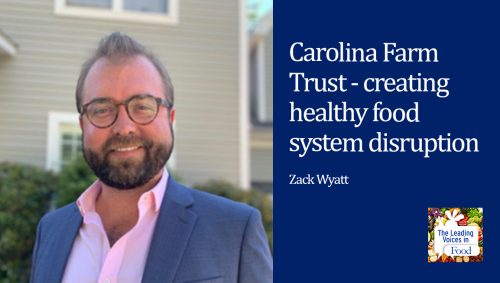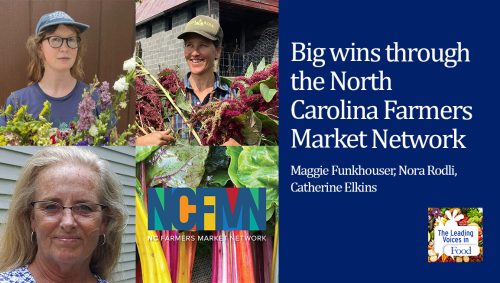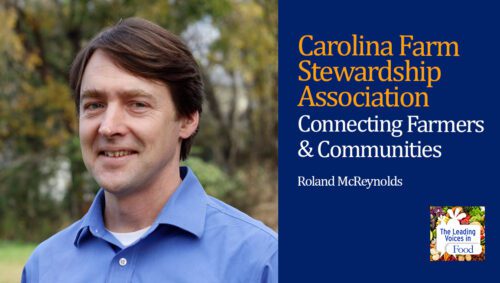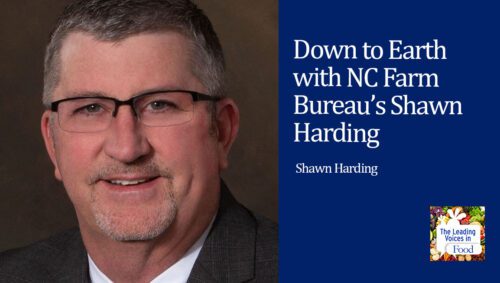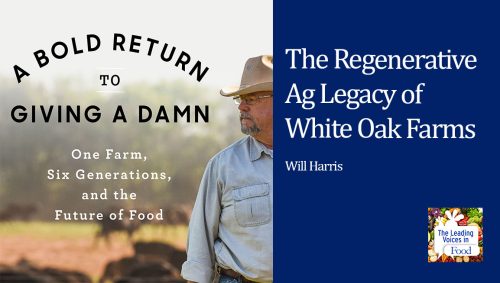The Leading Voices in Food
E50: Gwen’s Cotton
Today we’re talking with Gwen Pitt at the Pitt Family Farm located in Macclesfield, North Carolina, a rural city in Edgecombe County with a population of just 477 people. Gwen is the scout at the Pitt Farm. She scours cotton and sweet potato fields on the 1100 acres she farms with Burt Pitt, her husband of 40 years, looking for insects and testing the soil.
Subscribe: Apple Podcasts | TuneIN | Google Podcasts | SoundCloud | PocketCasts | Radio Public
Tags: Agriculture & Tech | North Carolina | Voice of Farming |

Gwen Pitt is a co-owner of the Pitt Family Farm located in Macclesfield, North Carolina, a rural city in Edgecombe County with a population of just 477 people.
Welcome to The Leading Voices in Food podcast, an educational series produced by the World Food Policy Center at Duke University. I’m Deborah Hill. You’re listening to a segment in our Voice of Farming series. Today we’re talking with Gwen Pitt at the Pitt Family Farm located in Macclesfield, North Carolina, a rural city in Edgecombe County with a population of just 477 people.
Agriculture is the leading industry here. Fields of tobacco and corn, sweet potatoes and soybeans, and of course cotton dominate the landscape running right up to the edge of freshly mown lawns. Houses are grouped in clusters, signaling extended families living and working together on family owned land. It’s a tradition of life that goes back so many generations that numerous farms in the area also have private family cemetery grounds with headstones dating back to the 1800s.
Gwen is the scout at the Pitt Farm. She scours cotton and sweet potato fields on the 1100 acres she farms with Burt Pitt, her husband of 40 years, looking for insects and testing the soil.
Right now the cotton has completed its flowering stage and there are bolls. So now we just sit and wait for a little bit, and then as it starts turning cooler that they’ll pop open and then it’ll be time. Of course, you’ve got to go in and defoliate it. We will defoliate, which means we will put something on it that will make the leaves die and drop off. You can’t pick it with the cotton picker if the leaves are still on it because then you end up with green lint and then you’ll be docked for that. They will test the cotton when it gets to the gin as to the whiteness, as to the size of the fiber.
And then most of our cotton, what we grow, goes to making jeans or T-shirts. Every crop has its purpose, and every crop goes to a certain area so that we can all have what we want in the grocery stores or in the stores. It’s going to be there for us to have T-shirts, jeans, or nice shirts.
So the bolls will finish maturing, and then they’ll pop open, and then you’ll see, hopefully, a field full of white, almost like snow. Our daughter, when she got married, she told her dad at the beginning of the year, she wanted to get married in October, and she said, “Your only job is to make sure the cotton is white on both sides of the path.” She got married on the front porch, and it was the most beautiful crop we had had. It was pretty.
Globally the US is the third largest producer of cotton behind China and India. Most of America’s cotton comes from southern states in the so-called Cotton Belt. North Carolina is the country’s eighth largest cotton producer.
Twenty years ago, we were raising cotton then, you always have to have a scout to go out and check for the insects. And they would be different insects that would destroy the boll, the worms that would get in it, the stinkbugs, such as that. If you hire a contract scout, it could cost upwards of $10,000 for a season.
So I looked at it, and my husband’s like, “You could do this.” And I said, “Yes, I can do that to save this farm that much money.” So went to the extension agent, and he actually came out and literally showed me how to scout. Actually he said, “You will do better than a contract because the contract worker gets in here one week at the first of the week, then they’ve got other farmers they have to go to. So then that one, it takes them a while to get back, and then in the meantime you may have some more bugs, a flight that comes in to where you needed to have sprayed two days before she gets back.” Whereas I’m here, I’m hands on, I can go out there every day and check if I need to, if I feel the need to. And I enjoy doing that.
I do the soil samples late fall and early, well, February, March, I’m out there doing the soil sampling now because I’ve got a Kubota, go around, do the boundaries, go out there and do soil sampling. And I’ve gotten that to where we have a local lab that I can just pick up and take to, it saves time.
When you start hiring out those kind of jobs, it’s costly and like you say, they may get to you or you may have to wait a week before they can get to you. And time sometimes is of the essence. It saves us money and this day and time with the low commodity prices, sometimes the disasters, it does save us money to do it that way.
And that’s when I’ve gotten more and more involved, seeing things that I can do, and actually when I learn to do them. They’re really interesting to learn about the different soils and what it takes for the different crops, and then too, the insects. You know, I’m scared to death of a spider crawling in my house, but now I can go out there and look for the stinkbugs and see all those wasp and everything. It doesn’t bother me. I’ve been lucky that I have not come upon a snake or anything.
So I enjoy what I do. It’s rewarding. It is rewarding that I can be here and then start doing things around the home or get the grandchildren now, helping, and we’re seeing that, you know, they are very interested in farming. The first word out of the youngest’s mouth, it wasn’t mama it was tractor. And that just tore her out of the frame that he said tractor before he said mama.
I have two grandsons. We have one daughter, and she does live right across on the farm. I think they realize that they wanted them to have the farm life. They really did. My son-in-law said he wanted the grandchildren to be able to come out the back door. He wanted them to have that experience to be able to go to grandma’s and go to the barn. They love to go to the barn and have supper or have lunch. We’ll have lunch out at the barn.
Cotton is graded in several ways such as fiber length, the uniformity, fineness and strength of the fiber, and how clean the cotton is in the bale. Cotton is also graded by color, namely the gradation of gray to white to yellow and the presence of any spots. Bright white is considered the highest quality. Farmers can influence cotton color by having good leaf defoliation and by getting the crop harvested before wet weather damages the fiber color.
Well, of course, you know they used to pick the cotton by hand I don’t know how many generations ago. That was probably two, three generations ago. Now, it is with the harvester, well, a cotton picker. A cotton picker, if you’re not familiar with, when you go buy a cotton picker, I know it used to be like $400,000. We’ve had one now, so I know the prices have probably steadily gone up. You’ve got one man running that.
The cotton picker goes through and just pulls the lint, which is the white, the cotton itself, the fiber, pulls it out of each one of those pods, so the sticky parts, which used to cut people’s hands, is left in the field. And then you come along afterwards and mow the stalks. And so the picker only picks the fiber and the seed. It just kind of pulls it out of the boll, puts it in the back, and then you dump it into the boll buggy, which carries it to the module builder and presses it in.
When it gets to the gin, that’s when they separate the seed from the lint. And then they do sell the seed, and you know, we get a little bit for the seed, or either we put it into the cost of the ginning.
And then we market it through a broker that actually sits there and watches the prices constantly. So he’s on the computer every day, and he’s shooting us emails every day, or either phone calls if he thinks we need to move on something. So you know, that kind of thing has changed over the years to where you don’t just take it to a market. You’ve got someone up there sitting there at a computer watching it for you day after day, and saying, “Yes, we need to book some,” or “We don’t need to book right now.”
And hopefully at the end of the year, you’ve done well at that and your prices are where you can handle them. But like I say, the price has dropped so low right now because of tariffs that I’m just hoping it’s going to go back up before time to sell it, you know. I think the more that I learn, the more Burt calls on me to do it because sometimes you can be too efficient.

